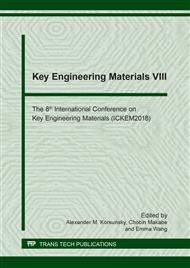[1]
R. Dele, Application of plastics and paper as food packaging materials: An overview. Emir. J. Food Agric 25(3) (2013) 177-188.
DOI: 10.9755/ejfa.v25i3.11509
Google Scholar
[2]
T. A. Dankovich and J. A Smith, Incorporation of copper nanoparticles into paper for point-of-use water purification. Water Research 63, (2014) 245-251.
DOI: 10.1016/j.watres.2014.06.022
Google Scholar
[3]
M. Jasai, S. Baruah, and J. Dutta, Paper modified with ZnO nanorods- antimicrobial studies. Beilstein Journal of Nanotechnology 3 (2012) 684-691.
DOI: 10.3762/bjnano.3.78
Google Scholar
[4]
N. C. T., Martins, C. S. R. Freire, C. P. Neto, A. J. D.Silvestre, J. Causio, G. Baldi,P. Sadocco and T. Trindade, Antibacterial paper based on composite coatings of nanofibrillated cellulose and ZnO. Colloids Surf A Physicochem Eng Asp, 417 (2013).
DOI: 10.1016/j.colsurfa.2012.10.042
Google Scholar
[5]
V. L. Prasanna and R. Vijayaraghavan, Insight into the mechanism of antibacterial activity of ZnO: Surface defects mediated reactive oxygen species even in the dark. Langmuir 31(33) (2015) 9155-9162.
DOI: 10.1021/acs.langmuir.5b02266
Google Scholar
[6]
S. Baruah, M, Jaisai, R. Imani, M. Nazhdad and J. Dutta, Photocatalytic paper using zinc oxide nanorods. Science and Technology of Advance Materials 11(5) (2010).
DOI: 10.1088/1468-6996/11/5/055002
Google Scholar
[7]
K. Ghule, A.V. Ghule, B.J. Chen and Y.C. Ling, Preparation and characterization of ZnO nanoparticles coated paper and its antibacterial activity study. Green Chem. 8 (2006) 1031-1041.
DOI: 10.1039/b605623g
Google Scholar
[8]
P.T. Selvan, M. Venkatachalam, M. Saroja, P. Gowthaman, S. Ravikumar and S. Shankar, Influence of growth time on zinc oxide nanorods prepared by dip coating method. International Journal of Innovative Research in Science, Engineering and Technology 3(9) (2014).
DOI: 10.15680/ijirset.2014.0309077
Google Scholar
[9]
Y. I. Xing, Z. H. Xi, Z. Q. Xue, X. D. Zhang, J. H. Song, R. M. Wang, J. Xu, Y. Song, S. L. Zhang and D. P. Yu, Optical properties of the ZnO nanotubes synthesized via vapor phase growth. Appl. Phys. Lett. 83(9) (2003) 1689-1691.
DOI: 10.1063/1.1605808
Google Scholar
[10]
Y. Liu and J. Lian, Optical and electrical properties of aluminum-doped ZnO thin films grown by pulse laser deposition. Appl. Surf. Sci. 253(7) (2007) 3727-3730.
DOI: 10.1016/j.apsusc.2006.08.012
Google Scholar
[11]
V.R. Shinde, T.P. Gujar, T. Noda, D. Fujita, A. Vinu, M. Grandcolas and J. Ye, Growth of shape- and size-selective zinc oxide nanorods by a microwave-assisted chemical bath deposition method: effect on photocatalysis properties. Chem. Eur. J. 16 (2010).
DOI: 10.1002/chem.200903370
Google Scholar
[12]
A. K. Singh and U. T. Nakate, Photocatalytic properties of microwave-synthesized TiO2 and ZnO nanoparticles using malachite green dye. J. Nanopart. Res. (2013) 1-7.
DOI: 10.1155/2013/310809
Google Scholar
[13]
A. Hatamie, A. Khan, M. Golabi, A. P. F. Turner, V. Beni, W.C Mak, A. Sadollahkhani, H. Alnoor, B. Zargar, S.Bano, O. Nur and M. Willander, Zinc Oxide Nanostructure-Modified Textile and Its Application to Biosensing, Photocatalysis, and as Antibacterial Material. Langmuir 31 (39) (2015).
DOI: 10.1021/acs.langmuir.5b02341
Google Scholar
[14]
A. Sirelkhatim, S. Mahmud, A. Seeni, N. Haida, M. Kaus, L. C. Ann, S. K. M. Bakhori, H. Hasan and D. Mohamad, Review on Zinc Oxide Nanoparticles: Antibacterial Activity and Toxicity Mechanism. Nano-Micro Lett. 7(3) (2015).
DOI: 10.1007/s40820-015-0040-x
Google Scholar
[15]
A. Stankovic, S. Dimitrijevic´ and D. Uskokovic´, Influence of size scale and morphology on antibacterial properties of ZnO powders hydrothermally synthesized using different surface stabilizing agents. Colloids Surf. B 102, 21–28 (2013).
DOI: 10.1016/j.colsurfb.2012.07.033
Google Scholar
[16]
K.A. Tam, Djurisˇic´, C. Chan, Y. Xi, C. Tse, Y. Leung, W. Chan, F. Leung, D. Au, Antibacterial activity of ZnO nanorods prepared by a hydrothermal method. Thin Solid Films 516(18), 6167–6174 (2008).
DOI: 10.1016/j.tsf.2007.11.081
Google Scholar
[17]
L.V.A. Stankovic, S. Markovic´, S. Dimitrijevic´, S.D. Sˇkapin, D. Uskokovic´, Morphology Controlled hydrothermal synthesis of ZnO particles and examination of their antibacterial properties on Escherichia coli and Staphylococcus aureus bacterial cultures, in Tenth Young Researchers' Conference—Materials Science and Engineering, Belgrade, Serbia, 21–23 December 2011 (Institute of Technical Sciences of SASA, Belgrade, 2011), p.62.
Google Scholar
[18]
F. Ahmed, S. Kumar, N. Arshi, M. S. Anwar, B. H. Koo and C. G. Lee, Rapid and cost effective synthesis of ZnO nanorods using microwave irradiation technique. Funct. Mater. Lett. 4(1) (2011) 1-5.
DOI: 10.1142/s1793604711001531
Google Scholar
[19]
H. Wang, J. Xie, K.Yan and M. Duan, Growth mechanism of different morphologies of ZnO crystals prepared by hydrothermal growth. J. Mater. Sci. Technol. 27(2) (2011) 153-158.
DOI: 10.1016/s1005-0302(11)60041-8
Google Scholar
[20]
S. Horikoshi and N. Serpone (Eds.), Microwave in nanoparticle synthesis: Fundamentals and Applications. (2013). Wiley-VCH Verlag GmbH & Co. KGaA, Boschstr. 12, 69469 Weinheim, Germany.
DOI: 10.1080/10426914.2016.1176196
Google Scholar


